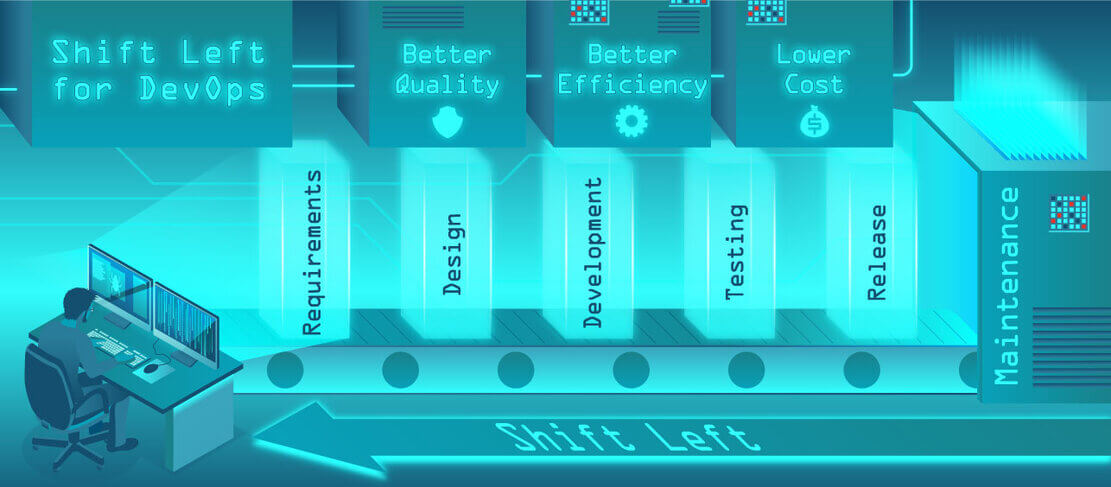In the world of information security, the term shift left has been gaining popularity in recent years. But what is shift left security? In simple terms, it’s the practice of identifying and fixing security and quality issues early in the software development lifecycle (SDLC)—long before deployment. Instead of performing all testing at the end, teams build automated, continuous testing and security validation directly into development. This proactive approach reduces risk, saves costs, and ensures secure software delivery. You can learn more in APIsec’s guide to shift-left security.
In this guide, we’ll take a closer look at how shift left security works, why it’s become critical for DevSecOps, and how you can adopt it within your organisation.
Executive Summary
The shift-left strategy embeds testing and security checks early in development. This approach speeds up releases, lowers costs, and improves software quality. Organisations embracing it report faster delivery times, stronger collaboration, and a measurable drop in post-release vulnerabilities.
Chapter 1: Shift-left vs. Traditional Testing

The idea of moving testing earlier in the SDLC gained traction when teams realised that finding and fixing bugs late in development was expensive and slow. Studies show that fixing a defect during design costs up to 100x less than fixing it after release.
The purpose of shift-left testing is to catch defects before they cause damage, improving product reliability while accelerating development cycles.
The most effective shift-left programs are grounded in a consistent devsecops methodology that defines how and when to test APIs throughout the lifecycle.devsecops process
Comparative Overview: Traditional, Shift-Right, and Shift-Left Testing
Testing can happen at different points in development but when it happens determines how effective and costly it is.
In traditional testing, QA validates software after the build. In shift-right, testing continues post-release using A/B and canary tests. Shift-left testing flips the process developers and testers validate continuously as the code evolves, creating a feedback loop that prevents major issues before production.
Real-World Examples and Context
The advantages of shift-left testing are best shown through practical examples.
A common case is the Broken Object Level Authorization (BOLA) vulnerability, one of the top API security threats today. As APIsec’s blog on BOLA explains, poor validation can expose sensitive data to unauthorised users. In one USPS incident, weak logic allowed users to access other customers’ personal information.
Shift-left testing prevents this by running logic and access control tests as soon as code is written, not after release. Early discovery stops vulnerabilities before they reach production, reducing both damage and remediation time.
Similarly, enterprises using automated API testing tools like APIsec have seen over 40% reduction in manual testing effort and caught 70% more vulnerabilities during pre-release phases.
Why Shift Left Benefits DevOps
DevOps thrives on speed and automation, yet many security processes remain manual and reactive. With developers now outnumbering security professionals 500 to 1 (GitHub 2023), embedding automated checks into CI/CD workflows is critical.
According to GitLab’s 2023 DevSecOps Report:
- Organisations using shift-left methods saw a 45% improvement in code quality.
- Delivery times improved by 64%, thanks to fewer bottlenecks.
- Team productivity increased by 60% due to integrated security automation.
Early testing helps teams move faster and avoid the exponential costs of fixing vulnerabilities late in development.
Chapter 2: How Shift Left Impacts Security
Integrating CI/CD and Automation
Modern development pipelines depend on Continuous Integration and Continuous Deployment (CI/CD) to release updates quickly. Each time a developer commits code, automated workflows build, test, and deploy it.
Integrating security scans into this cycle ensures every update is validated before it moves forward. Tools like APIsec seamlessly connect with CI/CD systems to run continuous API security checks, ensuring that authentication, authorisation, and business logic are tested automatically. For implementation tips, see APIsec’s DevSecOps and API Security guide.
Automation is key to scalability it reduces human error, eliminates repetitive tasks, and ensures that security evolves with each code change.
Cultural and Team Alignment
Technology can only take shift-left so far; the rest depends on mindset. Traditional development separates QA, DevOps, and security. Shift-left brings these groups together.
Teams that succeed treat security as a shared responsibility. Developers understand secure coding, QA engineers learn to identify logic flaws, and security professionals act as enablers rather than gatekeepers. This collaborative culture shortens review cycles and embeds security awareness into everyday coding habits.
Driving Technologies for Shift-Left Security
Different tools work at various SDLC stages to strengthen early security. These include:
Each tool offers unique advantages. Combining them creates layered defence.
For a breakdown of how these testing methods work together, see APIsec’s comparison of SAST and DAST.
Chapter 3: How to Maximise Your Shift-Left Strategy

To maximise the impact of shift-left testing, start small, measure results, and expand progressively.
A fintech company that introduced automated testing through APIsec reduced manual QA workload by 40% and found more than twice as many logic flaws before deployment. These improvements demonstrate how early automation creates measurable value in both time and security posture.
Best practices to strengthen your strategy include:
- Testing continuously but only when results provide actionable insights.
- Encouraging developer–tester collaboration and shared responsibility.
- Embedding automated API security scans into CI/CD pipelines (API Testing Automation Guide).
- Maintaining ongoing visibility even after release through continuous monitoring.
Chapter 4: How to Implement Shift-Left Security

Implementing shift-left security requires more than tools it needs structure, ownership, and continuous iteration.
Define Responsibilities
A successful shift-left approach starts with clear role definitions. Developers own the quality and security of their code, QA teams verify it across functionality and performance, and security engineers design the testing frameworks that monitor vulnerabilities. Assigning metrics and KPIs for each role builds accountability and ensures no part of the pipeline is overlooked.
Map the Pipeline
Mapping your software delivery process gives visibility into how code moves from design to deployment. Documenting these stages helps teams pinpoint where vulnerabilities can appear and where security checks should occur. Once the pipeline is mapped, automation can be applied at critical handoff points, ensuring every update is scanned, validated, and tracked.
Secure APIs
APIs are among the most common attack surfaces. To secure them, integrate security into the build process itself:
- Implement authentication and authorisation using OAuth 2.0 or OpenID Connect.
- Apply TLS/SSL encryption to protect data in transit.
- Enforce rate-limiting to prevent abuse and DoS attacks.
Embedding these standards early ensures APIs are secure by design, not patched reactively later.
Automate Scanning
Manual penetration testing is valuable but too slow for fast-moving pipelines. Automated scanning enables continuous validation. Platforms like APIsec integrate directly with CI/CD workflows to simulate attack scenarios, identify weak points, and produce remediation reports in real-time. This approach makes API testing part of the development rhythm rather than a separate phase.
Iterate Quickly
Shift-left is a continuous loop. Every time a bug or vulnerability is fixed, it should be retested to ensure no new issue was introduced. This rapid cycle of detection and correction helps teams maintain security without slowing down delivery.
Many early vulnerabilities originate from business logic flaws.
For guidance on spotting and resolving them early, read APIsec’s guide on business logic vulnerabilities.
Chapter 5: Shift-Left Best Practices
Shifting left requires both discipline and gradual change. Implementing everything at once can overwhelm teams, so start small and build momentum.
Build Unified QA and Deployment Procedures
Disjointed processes create confusion and errors. When QA and DevOps follow unified testing and deployment standards, it ensures consistency. Shared procedures align expectations, reduce last-minute issues, and guarantee that each release passes through the same security and quality benchmarks.
Start Small, Then Scale
Select one product or microservice as your pilot project. Apply shift-left principles there first automate tests, embed scanning tools, and measure outcomes. Once results show improved security and speed, roll out the same framework across other applications. Gradual adoption allows smoother integration and higher long-term success rates.
Simulate Real Environments
Testing should replicate real-world conditions as closely as possible. Staging environments that mirror production reveal issues that controlled test setups might miss. This practice ensures your code behaves securely and reliably under realistic workloads and configurations.
Prioritise Continuous Testing
Continuous testing ensures quality at every stage of development. Instead of large test cycles at the end, smaller automated checks run throughout, validating every code change. This early feedback reduces risk, prevents regressions, and ensures faster, safer releases.
Automate CI/CD Pipelines
Automation ensures repeatability and consistency. Integrate automated builds, tests, and deployments into your CI/CD pipeline. When combined with security scans, it guarantees that vulnerabilities are caught automatically before release.
For best results, follow APIsec’s automation guide to align your pipelines with industry standards.
Why Shift-Left Security Matters
Shift-left security transforms development from reactive to proactive. By identifying risks earlier, teams release faster, reduce costs, and protect users more effectively.
As highlighted in APIsec’s automation platform overview, integrating automated API testing into DevSecOps pipelines turns security from a last-minute hurdle into a competitive advantage.
Key Takeaways
- Shift-left security embeds testing early in development, preventing high-cost vulnerabilities later.
- Integrating checks into CI/CD pipelines keeps every update secure without slowing releases.
- Using tools like SAST, DAST, IAST, SCA, and RASP provides end-to-end protection across all stages.
- Identifying business logic flaws early drastically reduces breaches and compliance risks.
- Collaboration between DevOps, QA, and security teams is essential for long-term adoption.
- Partnering with APIsec’s automated testing platform enhances scalability, coverage, and trust.
FAQs
Q.1 What is shift-left security?
It’s the integration of security testing early in the SDLC to detect and fix vulnerabilities before production.
Q.2 How does it differ from traditional or shift-right testing?
Traditional testing happens post-development, shift-right after release, while shift-left runs continuously during development.
Q.3 Which tools support shift-left practices?
Tools like SAST, DAST, IAST, SCA, and RASP each address different SDLC stages.
Q.4 How does automation help?
Automation embeds testing into CI/CD pipelines, enabling faster, consistent, and more reliable results.
Q.5 What’s the biggest challenge in shifting left?
Cultural alignment ensuring all teams share responsibility for security and quality.
Q.6 How can APIsec help?
APIsec automates API scanning, logic validation, and vulnerability detection, helping teams fully adopt shift-left DevSecOps practices.
.webp)

.webp)

